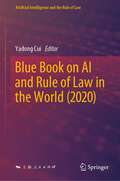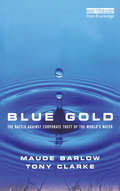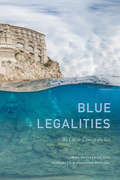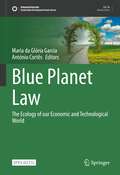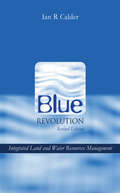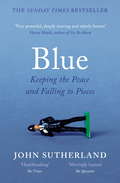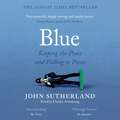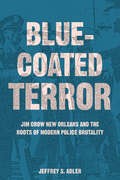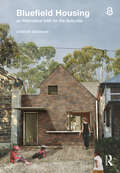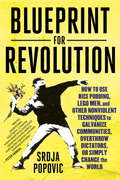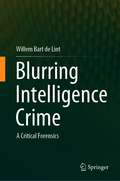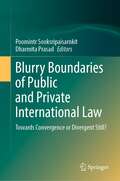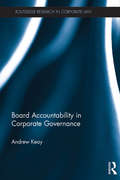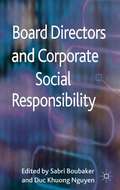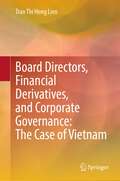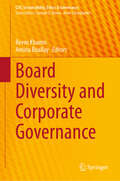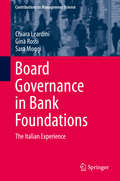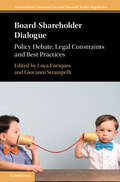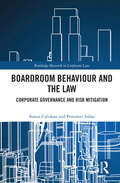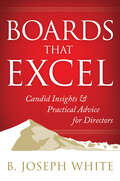- Table View
- List View
Blue Book on AI and Rule of Law in the World (Artificial Intelligence and the Rule of Law)
by Yadong CuiThis book focuses on the development of artificial intelligence and rule of law in the current world. It covers topics such as AI strategy, policy, law, theoretical research, and practical application. Through an in-depth analysis and thorough evaluation, this book provides a more objective, fair, accurate and comprehensive report. The purpose is to lead the AI and rule of law research and create an AI and rule of law environment which is conducive to the construction of AI and rule of law system. In particular, it aims to play an active role in promoting the establishment of legal systems, policy systems, and codes of ethics that are compatible with the innovative development of AI, thus facilitating the implementation of a new generation of AI development strategies, and ensuring the safe, reliable, controllable, healthy, and sustainable development of AI.
Blue Book on AI and Rule of Law in the World (Artificial Intelligence and the Rule of Law)
by Yadong CuiThis book focuses on the development of artificial intelligence and rule of law in the world, by collecting and summarizing the information about the development of artificial intelligence and rule of law in China and the world, covering topics like AI strategy, policy, law, theoretical research and practical application, etc. It makes an in-depth analysis so as to provide an objective, fair and accurate report. The purpose is to promote the study of AI and law, promote the construction of AI and rule of law system and create an AI and rule of law environment. In particular, it aims to play an active role in promoting the establishment of legislative norms, legal systems, policy systems and ethical norms that are compatible with the innovative development of AI, promoting the implementation of a new generation of national AI development strategies, ensuring the safe, reliable, controllable, healthy and sustainable development of AI. It is hoped that this book may provide useful reference for researchers of AI and law.
Blue Extinction in Literature, Art, and Culture (Palgrave Studies in Animals and Literature)
by Rachel Murray Vera FibisanBlue Extinction in Literature, Culture, and Art examines literary and cultural representations of aquatic biodiversity loss, bringing together critical perspectives from the blue humanities and extinction studies. It demonstrates the affordances, as well as the limitations, of literary and artistic forms in exposing the plight of aquatic organisms, drawing attention to the social, political, and economic structures that are contributing to their destruction. Together, the essays in this collection demonstrate how literature and art can challenge dominant cultural conceptions and lingering misconceptions surrounding aquatic biodiversity loss, offering new ways of relating to species ranging from whales to oysters.
Blue Gold: The Battle Against Corporate Theft of the World's Water
by Maude Barlow Tony ClarkeInternational tensions around water are rising in many of the world's most volatile regions. The policy recipe pursued by the West, and imposed on governments elsewhere, is to pass control over water to private interests, which simply accelerates the cycle of inequality and deprivation. California, as well as China, South Africa, Mexico and countries on every continent already face a crisis. This book exposes the enormity of the problem, the dangers of the proposed solution and the alternative, which is to recognize access to water as a fundamental human right, not dependent on ability to pay.
Blue Legalities: The Life and Laws of the Sea
by Irus Braverman Elizabeth R. Johnson Eds.The ocean and its inhabitants sketch and stretch our understandings of law in unexpected ways. Inspired by the blue turn in the social sciences and humanities, Blue Legalities explores how regulatory frameworks and governmental infrastructures are made, reworked, and contested in the oceans. Its interdisciplinary contributors analyze topics that range from militarization and Maori cosmologies to island building in the South China Sea and underwater robotics. Throughout, Blue Legalities illuminates the vast and unusual challenges associated with regulating the turbulent materialities and lives of the sea. Offering much more than an analysis of legal frameworks, the chapters in this volume show how the more-than-human ocean is central to the construction of terrestrial institutions and modes of governance. By thinking with the more-than-human ocean, Blue Legalities questions what we think we know—and what we don&’t know—about oceans, our earthly planet, and ourselves. Contributors. Stacy Alaimo, Amy Braun, Irus Braverman, Holly Jean Buck, Jennifer L. Gaynor, Stefan Helmreich, Elizabeth R. Johnson, Stephanie Jones, Zsofia Korosy, Berit Kristoffersen, Jessica Lehman, Astrida Neimanis, Susan Reid, Alison Rieser, Katherine G. Sammler, Astrid Schrader, Kristen L. Shake, Phil Steinberg
Blue Planet Law: The Ecology of our Economic and Technological World (Sustainable Development Goals Series)
by Maria da Glória Garcia António CortêsBlue Planet Law is the global and future-oriented environmental law that is necessary to face the global environmental crisis in the Anthropocene, assuming especially the link between climate action (SDG 13) and ocean sustainability (SDG 14). This open access book focuses on means of overcoming global environmental problems such as climate change, ocean degradation and biodiversity loss and the consequent risks for human life, health, food and wellbeing. It explores how environmental law, at the international, European and national levels, might set economic and technological development on a more sustainable path. Law must engage in dialogue with other areas such as philosophy, economics, ecology, and biology. This book highlights protection of the climate and the oceans and sustainable use of natural resources, through new policies, economies and technologies, including biotechnology, with a view to the preservation of life, health, food and a healthy environment for the present and future generations. The book may be seen as a contribution to the UN Sustainable Development Goals 13 and 14 and a tribute to the Declaration of the United Nations Conference on the Human Environment, also known as the Stockholm Conference (1972), on its 50th Anniversary.
Blue Revolution: Integrated Land and Water Resources Management
by Ian Calder'Blue Revolution upturns some environmental applecarts - not for the hell of it, but so we can manage our environment better.' Fred Pearce, New Scientist This updated and revised edition of The Blue Revolution provides further evidence of the need to integrate land management decision-making into the process of integrated water resources management. It presents the key issues involved in finding the balance between the competing demands for land and water: for food and other forms of economic production, for sustaining livelihoods, and for conservation, amenity, recreation and the requirements of the environment. It also advocates the means and methodologies for addressing them. A new chapter, 'Policies, Power and Perversity,' describes the perverse outcomes that can result from present, often myth-based, land and water policies which do not consider these land and water interactions. New research and case studies involving ILWRM concepts are presented for the Panama Canal catchments and in relation to afforestation proposals for the UK Midlands.
Blue on Blue: An Insider's Story of Good Cops Catching Bad Cops
by Gordon Dillow Charles CampisiOne of the most authentic and consistently illuminating portraits of police work ever, Blue on Blue describes the fascinating inner workings of the world’s largest police force and Chief Charles Campisi’s unprecedented two decades putting bad cops behind bars.From 1996 through 2014 Charles Campisi headed NYPD’s Internal Affairs Bureau, working under four police commissioners and gaining a reputation as hard-nosed and incorruptible. When he retired, only one man on the 36,000-member force had served longer. During Campisi’s IAB tenure, the number of New Yorkers shot, wounded, or killed by cops every year declined by ninety percent, and the number of cops failing integrity tests shrank to an equally startling low. But to achieve those exemplary results, Campisi had to triple IAB’s staff, hire the very best detectives, and put the word out that bad apples wouldn’t be tolerated. While early pages of Campisi’s absorbing account bring us into the real world of cops, showing, for example, the agony that every cop suffers when he fires his gun, later pages spotlight a harrowing series of investigations that tested IAB’s capacities, forcing detectives to go undercover against cops who were themselves undercover, to hunt down criminals posing as cops, and to break through the “blue wall of silence” to verify rare—but sometimes very real—cases of police brutality. Told in an edge-of-the-seat way by a born storyteller, Blue on Blue puts us in the scene, allowing us to listen in on wiretaps and feel the adrenaline rush of drawing in the net. It also reveals new threats to the force, such as the possibility of infiltration by terrorists. Ultimately, the book inspires awe for the man who, for almost two decades, was entrusted with the job of making sure the words “New York’s Finest” never ring hollow. A truly revelatory account, Blue on Blue will forever change the way you view police work.
Blue: A Memoir Keeping the Peace and Falling to Pieces
by John SutherlandA Sunday Times top-five bestseller'This is a remarkable book . . . profound and deeply moving . . . It has as much to tell us about mental illness as it does about policing' Alastair StewartJohn Sutherland joined the Met in 1992, having dreamed of being a police officer since his teens. Rising quickly through the ranks, he experienced all that is extraordinary about a life in blue: saving lives, finding the lost, comforting the broken and helping to take dangerous people off the streets. But for every case with a happy ending, there were others that ended in desperate sadness, and in 2013 John suffered a major breakdown.Blue is his memoir of crime and calamity, of adventure and achievement, of friendship and failure, of serious illness and slow recovery. With searing honesty, it offers an immensely moving and personal insight into what it is to be a police officer in Britain today.
Blue: A Memoir – Keeping the Peace and Falling to Pieces
by John SutherlandA Sunday Times top-five bestseller'This is a remarkable book . . . profound and deeply moving . . . It has as much to tell us about mental illness as it does about policing' Alastair StewartJohn Sutherland joined the Met in 1992, having dreamed of being a police officer since his teens. Rising quickly through the ranks, he experienced all that is extraordinary about a life in blue: saving lives, finding the lost, comforting the broken and helping to take dangerous people off the streets. But for every case with a happy ending, there were others that ended in desperate sadness, and in 2013 John suffered a major breakdown.Blue is his memoir of crime and calamity, of adventure and achievement, of friendship and failure, of serious illness and slow recovery. With searing honesty, it offers an immensely moving and personal insight into what it is to be a police officer in Britain today.
Blue: A Memoir – Keeping the Peace and Falling to Pieces
by John SutherlandA searingly honest memoir of life, policing and falling apart'Every contact leaves a trace'John Sutherland joined the Met in 1992, having dreamed of being a police officer since his teens. Rising quickly through the ranks, and compelled by the opportunity to make a real difference to people's lives, he worked across the capital, experiencing first-hand the enormous satisfaction as well as the endless trauma that a life in blue can bring.There were remarkable, career-defining moments: commanding armed sieges, saving lives and helping to take dangerous people off the streets. But for every case with a happy ending, there were others that ended in desperate sadness.In early 2013, John suffered a major breakdown and consequent battle with crippling depression. After a career spent racing to be the first at the scene of crimes and catastrophes, he found himself in pieces, unable to put one foot in front of the other.Blue is a memoir of crime and calamity, of adventure and achievement, of friendship and failure, of laughter and loss, of the best and the worst of humanity, of serious illness and slow recovery. With searing honesty, it offers an immensely moving and personal insight into what it is to be a police officer in Britain today.
Bluecoated Terror: Jim Crow New Orleans and the Roots of Modern Police Brutality
by Jeffrey S. AdlerA searing chronicle of how racist violence became an ingrained facet of law enforcement in the United States. Too often, scholars and pundits argue either that police violence against African Americans has remained unchanged since the era of slavery or that it is a recent phenomenon and disconnected from the past. Neither view is accurate. In Bluecoated Terror, Jeffrey S. Adler draws on rich archival accounts to show, in narrative detail, how racialized police brutality is part of a larger system of state oppression with roots in the early twentieth-century South, particularly New Orleans. Wide racial differentials in the use of lethal force and beatings during arrest and interrogation emerged in the 1930s and 1940s. Adler explains how race control and crime control blended and blurred during this era, when police officers and criminal justice officials began to justify systemic violence against Black people as a crucial—and legal—tool for maintaining law and order. Bluecoated Terror explores both the rise of these law-enforcement trends and their chilling resilience, providing critical context for recent horrific police abuses as the ghost of Jim Crow law enforcement continues to haunt the nation.
Bluefield Housing as Alternative Infill for the Suburbs
by Damian MadiganSuburbanised cities share a common dilemma: how to transition to more densely populated and socially connected urban systems while retaining low-rise character, avoiding gentrification, and opening neighbourhoods to more diverse housing choices. Bluefield Housing offers a new land definition and co-located infill model addressing these concerns, through describing and deploying the types of ad-hoc modifications that have been undertaken in the suburbs for decades. Extending green-, brown-, and greyfield definitions, it provides a necessary middle ground between the ‘do nothing’ attitude of suburban preservation and the ‘do everything’ approach of knock-down-rebuild regeneration. An adjunct to ‘missing middle’ and subdivision densification models, with a focus on co-locating homes on small lots, Bluefield Housing presents a unified design approach to suburban infill: retrofitting original houses, retaining and enhancing landscape and urban tree canopies, and delivering additional homes as low-rise additions and backyard homes suited to the increasingly complex make-up of our households. Extensively illustrated by the author with engaging architectural design studies, Damian Madigan describes how existing quirks of suburban housing can prompt new forms of infill, explains why a new suburban densification model is not only necessary but can be made desirable for varied stakeholders, and charts a path towards the types of statutory and market triggers required to make bluefield housing achievable. Using Australian housing as an example but addressing universal concerns around neighbourhood character, demographic needs, housing diversity, dwelling flexibility, and landscape amenity, Bluefield Housing offers innovative suburban infill ideas for policy makers, planners, architects, researchers and students of housing and design studies, and for those with a stake in the future of the suburbs.
Bluefield Housing as Alternative Infill for the Suburbs
by Damian MadiganSuburbanised cities share a common dilemma: how to transition to more densely populated and socially connected urban systems while retaining low-rise character, avoiding gentrification, and opening neighbourhoods to more diverse housing choices. Bluefield Housing offers a new land definition and co-located infill model addressing these concerns, through describing and deploying the types of ad-hoc modifications that have been undertaken in the suburbs for decades. Extending green-, brown-, and greyfield definitions, it provides a necessary middle ground between the ‘do nothing’ attitude of suburban preservation and the ‘do everything’ approach of knock-down-rebuild regeneration.An adjunct to ‘missing middle’ and subdivision densification models, with a focus on co-locating homes on small lots, Bluefield Housing presents a unified design approach to suburban infill: retrofitting original houses, retaining and enhancing landscape and urban tree canopies, and delivering additional homes as low-rise additions and backyard homes suited to the increasingly complex make-up of our households.Extensively illustrated by the author with engaging architectural design studies, Damian Madigan describes how existing quirks of suburban housing can prompt new forms of infill, explains why a new suburban densification model is not only necessary but can be made desirable for varied stakeholders, and charts a path towards the types of statutory and market triggers required to make bluefield housing achievable. Using Australian housing as an example but addressing universal concerns around neighbourhood character, demographic needs, housing diversity, dwelling flexibility, and landscape amenity, Bluefield Housing offers innovative suburban infill ideas for policy makers, planners, architects, researchers and students of housing and design studies, and for those with a stake in the future of the suburbs.The Open Access version of this book, available at www.taylorfrancis.com, has been made available under a Creative Commons Attribution-Non Commercial-No Derivatives (CC-BY-NC-ND) 4.0 license.
Blueprint for Revolution: How to Use Rice Pudding, Lego Men, and Other Nonviolent Techniques to Galvanize Communities, Overthrow Dictators, or Simply Change the World
by Matthew Miller Srdja PopovicA handbook for anyone who wants to effectively (and peacefully) improve your neighborhood, make a difference in your community, or change the world Blueprint for Revolution will teach you how to * make oppression backfire by playing your opponents' strongest card against them * identify the "almighty pillars of power" in order to shift the balance of control * dream big, but start small: <P><P>learn how to pick battles you can win * <br>listen to what people actually care about in order to incorporate their needs into your revolutionary vision <br>* master the art of compromise to bring together even the most disparate groups <br>* recognize your allies and view your enemies as potential partners <br>* use humor to make yourself heard, defuse potentially violent situations, and "laugh your way to victory".
Blurring Intelligence Crime: A Critical Forensics
by Willem Bart de LintThis book explores the conundrum that political fortune is dependent both on social order and big, constitutive crime. An act of outrageous harm depends on rules and protocols of crime scene discovery and forensic recovery, but political authorities review events for a social agenda, so that crime is designated according to the relative absence or presence of politics. In investigating this problem, the book introduces the concepts ‘intelligence crime’ and ‘critical forensics.’ It also reviews as an exemplar of this phenomenon ‘apex crime,’ a watershed event involving government in the support of a contested political and social order and its primary opponent as the obvious offender, which is then subject to a confirmation bias. Chapters feature case study analysis of a selection of familiar, high profile crimes in which the motives and actions of security or intelligence actors are considered as blurred or smeared depending on their interconnection in transactional political events, or according to friend/enemy status.
Blurry Boundaries of Public and Private International Law: Towards Convergence or Divergent Still?
by Poomintr Sooksripaisarnkit Dharmita PrasadThis book examines interactions and discusses intersectionality between public international law and private international law. With contributions from scholars from USA, Canada, Australia, India and EU, this book brings out truly international perspectives on the topic. The contributions are arranged in four themes—Public international law and private international law: historical and theoretical considerations of the boundary; Harmonisation of private international law by public international law instruments: evaluation of process, problems, and effectiveness; Case studies of intersectionality between public international law and private international law; Future trends in the relationship between public international law and private international law. The ultimate aim of this book is to analyse whether these two legal disciplines become convergent or they are still divergent as usual. With wide coverage spanning across these four themes, the book has takeaways for a wide readership. For scholars and researchers in the fields of public international law and private international law, this book sparks further thoughts and debates in both disciplines and highlight areas for continuing research. For practitioners, this book offers fresh insights and perspectives on contemporaneous issues of significance. This book is also be a great resource for students at both undergraduate and postgraduate levels taking subjects such as public international law or private international law or some related disciplines such as international sale of goods, international trade law or international investment law to advance their knowledge and understanding of the disciplines.
Board Accountability in Corporate Governance (Routledge Research in Corporate Law)
by Andrew KeayWithin corporate governance the accountability of the board of directors is identified as a major issue by governments, international bodies, professional associations and academic literature. Boards are given significant power in companies, and as a consequence it is argued that they should be accountable for their actions. Drawing on political science, public administration, accounting, and ethics literature, this book examines the concept of accountability and its meaning in the corporate governance context. It examines the rationale for making boards accountable, and outlines the obstacles and drawbacks involved in providing for accountability. The book goes on to examine how current mechanisms for ensuring accountability are assessed in terms of fairness, justice, transparency, practicality, effectiveness and efficiency, before discussing the ways that accountability might be improved. Andrew Keay argues that enhanced accountability can provide better corporate governance, helping to reduce the frequency and severity of financial crises, and improve confidence in company practice. As an in depth study of a key element within the exercise of authority and management in corporate entities, this book will be of great use and interest to researchers and students of corporate governance, business and management, and corporate social responsibility.
Board Directors and Corporate Social Responsibility
by Duc Khuong Nguyen Sabri BoubakerThis volume introduces readers to recent developments in the fields of board of directors and corporate social responsibility. It also provides new insights and perspectives on corporate governance practices in different countries.
Board Directors, Financial Derivatives, and Corporate Governance: The Case of Vietnam
by Tran Thi LienThis book gives readers a look inside the boardrooms and directors’ minds—a desirable but highly challenging task for researchers due to the lack of access to top teams in organizations. This book breaks through that barrier with a mixed-methods investigation of boardrooms in the emerging country of Vietnam particularly on the topic of financial derivatives. Directors are the leading players within the corporate governance framework. The general effectiveness of the board depends on their roles, processes and competencies. Given the scandals marring the history of the financial industry, this book aims to tackle the question of whether board directors have the financial acumen required to handle the tricky instruments of financial derivatives through interviews with board directors and analysis of their organizations. Providing a managerial perspective of financial derivatives, this distinguishes itself from more popular financial engineering books and would be a useful read for government officials, board directors, training organizations and scholars, particularly in Vietnam.
Board Diversity and Corporate Governance (CSR, Sustainability, Ethics & Governance)
by Reem Khamis Amina BuallayThis book brings together research that advances our understanding of the fundamental relationship between board diversity and different aspects of corporate governance, including corporate governance disclosures, board performance, governance characteristics, and ownership structure. The expertly selected chapters deal with related (but not limited) to the following topics: Corporate governance models and diversity; forms of diversity and decisions in the boardroom; Board diversity, corporate disclosure, and intellectual capital disclosures; shareholder activism; differences between private and family firms; Board diversity laws; gender and ethnicity on boards, and going beyond gender aspects of diversity. This book is particularly useful for researchers and practitioner think tanks to understand the state of the art in board diversity research.
Board Governance in Bank Foundations: The Italian Experience (Contributions to Management Science)
by Chiara Leardini Gina Rossi Sara MoggiBank foundations serve an important purpose in the Italian nonprofit sector. This book presents the legal grounds, areas of intervention, and basic tools involved in the asset management and grant-making activities that such organizations undertake. A special emphasis focuses on the analyses of the organizational structure of bank foundations and the relevant aspects of governance, particularly with regard to the composition, roles, and responsibilities of bank foundation boards. The general reduction in the resources to which they have access requires a new strategy that clearly defines long-term goals and the necessary procedures to achieve them. The topic of strategic planning is therefore also central to this text, which examines its peculiarities, content and governing bodies. The analysis of some case studies provides a better understanding of the manner in which foundations interpret strategic planning and reveals strengths and weaknesses that demand careful attention.
Board-Shareholder Dialogue: Policy Debate, Legal Constraints and Best Practices (International Corporate Law and Financial Market Regulation)
by Luca Enriques Giovanni StrampelliThis book provides corporate law scholars and students and practitioners at law firms, advisory services firms and asset managers with a comprehensive and rigorous analysis of the financial, managerial, policy and legal issues arising from a key feature of today's corporate governance environment, namely, the dialogue between shareholders and corporate boards. Bringing together top corporate law and corporate governance scholars from the world's leading academic institutions, the collection is characterized by a multi-dimensional approach that takes into account the particularities of some national legal systems and combines theoretical analysis with practical insights into various aspects of board-shareholder dialogue.
Boardroom Behaviour and the Law: Corporate Governance and Risk Mitigation (Routledge Research in Corporate Law)
by Samet Caliskan Pereowei SubaiThis book examines how various areas of law collectively influence the relationship between a company and its directors, particularly in safeguarding the long-term interests of stakeholders.Directors' inappropriate actions can expose a company to significant corporate risks, particularly in relation to regulatory violations such as breaches of competition law. When directors engage in such misconduct, company law and corporate governance provide certain control mechanisms that allow the company to manage these risks. Additionally, directors can be discouraged from engaging in such behaviour by the threat of being held accountable for violations of competition law. This book evaluates various tools designed to regulate directors' behaviours and ensure accountability, questioning whether the legal frameworks strike the right balance between corporate liability and personal accountability. It argues that these mechanisms do not sufficiently protect the long-term interests of stakeholders and that shortcomings in the law leave companies vulnerable to directors' misconduct, which cannot be adequately addressed through traditional risk management strategies.This book will be of interest to researchers in the field of corporate law, competition law, and corporate governance.
Boards That Excel: Candid Insights and Practical Advice for Directors
by B. Joseph WhiteThis is a different kind of corporate governance book. With its vivid stories and conversational tone, Boards That Excel is like sitting down with an astute and experienced friend—one who’s passionate about what corporate and nonprofit boards can contribute to their organizations’ success when they set high aspirations, are clear on purpose, and do the right things in the right way. B. Joseph White, an experienced corporate and nonprofit director and a distinguished academic, argues that boards can enable organizations to do great things, but only when directors go well beyond their duty to oversee and monitor management. White offers a road map for governance success based on his experience with two of America’s most successful companies, one public and one private. He knows governance research and distills it to a handful of truly useful insights for boards and directors. He provides clear guidance on the essential work boards must do, and, drawing on behavioral research, he describes how they can ensure the boardroom is a place of good information, thoughtful evaluation, and wise decision making. The book reports on interviews with more than a dozen high-performance board chairs, CEOs, and directors, including Siebel Systems founder Tom Siebel, legendary real estate investor Sam Zell, former Harlem Globetrotters owner Mannie Jackson, GM board chairman and former Cummins chairman and CEO Tim Solso, and volunteer (University of Illinois, University of Michigan) and corporate (Hershey, Bob Evans) director Mary Kay Haben. All speak with unusual candor on what it takes for boards and directors to excel.
